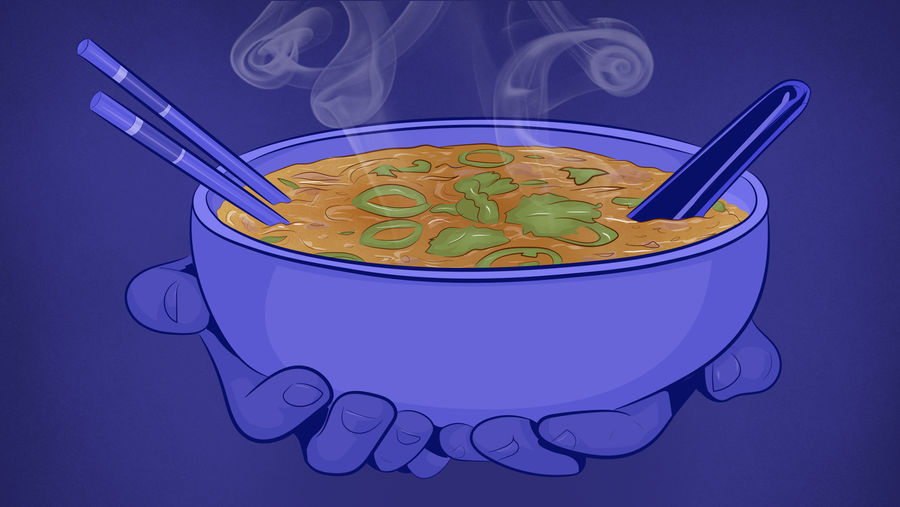How To Make Pho, A Heavenly Vietnamese Comfort Food

Even if you’ve never tasted Vietnamese food before, it’s likely you’ve heard of the cuisine’s two most popular foods, bánh mì and pho. Pronounced “fuh” or “foe” depending on the region, the latter is a fragrant noodle soup that’s a great comfort food, especially in the winter. Even a relatively mild one.
I discovered Vietnamese food fairly late, in my mid-twenties—the most appealing thing about pho, at first, was definitely the noodles. I had grown up a plump ‘80s kid with a taste for pasta; as a tween, that inclination (governed by a much cheaper budget) turned me onto Ramen, which undoubtedly explains my continued fascination with slurping any sort of noodle broth.
I’ll admit, the comparison to Ramen is a basic one. The history and heart of pho—a complex, somewhat murky narrative—lurks in the steamy cauldron of intensity that comes together in the waning moments with the addition of fish sauce. (The fish sauce is its defining ingredient.) That’s before your bowl is bombarded with thin slices of beef, or shrimp, or whatever meat you choose. The luxury afforded by the American table has added to that mélange, finishing the soup with an accompaniment of assorted veggies, teaspoon dollops of Sriracha and hoisin, and a siren song of sweet, savory herbs that make it unlike any soup you’ve ever buried your stupid, uncultured face into.
Pho is one of the original fusion foods of the 20th century, but its history is complicated and has been marked by three distinct events: The unification under French rule in 1887, which introduced the Vietnamese to Pot au Feu, a recipe they transformed to include their local foodstuffs; the splitting of the country into North and South Vietnam in 1954 (when political refugees fled communist rule and introduced the dish to their southern counterparts); and the fall of Saigon in 1975 (when two million Vietnamese left their homeland in search of freedom in North America, western Europe and Australia).
As much as I loved pho, making it on my own felt like an overwhelming prospect. When my girlfriend and I finally took on the task, one thing we knew for sure was that we wanted to make a stock fortified by oxtail and beef leg bones, and while some more gentrified recipes allow for chicken or vegetable stock, that’s a cop-out. So is going to your local grocery store, if there’s a specialty market nearby. You want to go to Chinatown or an Asian market where the smell of fish smacks you in the face. The bigger markets have everything you can imagine: buckets of live frogs, counters of exotic supplements, foreign fruits. But we were there for pho, and were able to find everything we needed pretty easily.
Ingredients
For a batch that will serve 8-12 people, pick up:
2 lbs. oxtail
3 lbs. beef leg bones (the package of bones I got said “Beff Feet,” but that was close enough)
1 large carrot (grab an extra if you want to shred and use for garnish)
1 small daikon (it’s a white radish)
2 large onions
2 chunks of fresh, whole ginger
1 large zucchini (Jenny and I used this to make our noodles so we didn’t have to break our diets, and it’s a good alternative for the noodles if you’re going low-carb)
2 cups bean sprouts
2 cups fresh pea pods (optional)
1 bunch of fresh cilantro
1 bunch fresh Thai basil
3 limes (five, if you’re making cocktails, too)
A handful of red and green chilis
Stalks of green onions
Pho noodles
Pho seasoning packet (Includes coriander seeds, cloves, star anise, cinnamon sticks, cardamom)
Fish sauce (grab a whole bottle)
Hoisin sauce
Sriracha
I was quite happy to find an all-inclusive pho seasoning packet, which had all the spices I needed (this even had the essential little cheesecloth sac in there), and my home fridge was already stocked with plenty of fish sauce and sriracha. I grabbed the oxtail and beef bones, glanced longingly at the pile of frogs and had a stilted but effective dialogue with the butcher, who held up his pinched thumb and index finger to show me just how thin the beef was sliced.
Directions
The real magic is in the stock. Even at the end of a long day of work and cell phone shopping, the prospect of creating was exciting. Something about harnessing the flavors of bones and vegetables has a synergy that can be rare in my workaday life.
Here’s what I did, step-for-step:
First, blanch the bones, which only takes a few minutes. Toss the oxtail pieces and beef bones in a medium-large stockpot, adding water to completely cover them. This can get kind of gross, because as it boils, a thick scum forms as a head, and it must be removed. Some recipes just take out the bones and start over with new water, but I just pulled out the scummy stuff with a spoon, strained it into a larger stockpot, and returned the bones after a quick cold water rinse.
As this simmers on medium-low heat, get the veggies ready. Cut the carrot, daikon and ginger in a few pieces, and quarter the onions. Throw these in a broiling pan and roast about 3-4 inches under the max broil (500-degrees in my oven) for about 20 minutes until a char forms over the onions, and the others are lightly browned. Remove the any charred layers of onion and jam that (along with the partially cooked daikon, carrot and ginger) into the simmering stock with the bones.
Toast your spices. This is when you’ll start salivating. Using a dry sauté pan, heat up the coriander seeds, cloves, star anise, cinnamon sticks and cardamom until the kitchen was filled with a smoky smell—not a burnt one, just one powerful enough to mask the marijuana. It’s a little tricky getting the toasted spices back into that miniature cheesecloth satchel included in the pho seasoning packet, but it can be done, especially if you use a spoon. The spice sack (ones filled with herbs are called bouquet garni—which can be tied together or in a sachet, like mine) gets tossed into the stock.
Set a timer for eight hours, and take a nap. Once the timer goes off, put the warm, strained stock into the fridge to cool off for a few more hours, and skim off the layer of fat that has formed atop the now-cool stock, and strain it once more, through a finer mesh this final time.
Chop up some toppings. Try lime wedges, slices of green onions, slices of green and red chilis, and bunches of the basil and cilantro. The raw beef slices, uncooked rice noodles, hoisin, fish sauce and Sriracha should be saved until you’re ready to eat.
Heat up the stock and add the fish sauce (to taste) and prep the rice noodles per the package directions by dropping in boiling water, removing from heat and soaking for a couple minutes before a cool rinse in a strainer. Ever watch somebody proof moonshine? That’s how you add the salt component to the broth, courtesy of the fish sauce. Add some, taste it, and add more if it’s not salty enough. Once it’s there, you’re ready to serve by ladling into bowl and adding the goodies. Here’s the best order:
Add three or four of the beef slices to the hot broth (they cook immediately)
Add the prepared rice noodles. If you’re off carbs, zucchini noodles are a great substitute.
Spoon in some sriracha and a little hoisin. The more sriracha, the hotter it’s going to be. Trust me, you do not need much of either.
Drop in the veggies you like, and some freshly pulled herbs.
Eat and repeat.
Here’s what it should look like when it’s ready to eat.
(Caption: The traditional garnish plate includes scallions, bean sprouts, chili peppers, lime wedges, Thai basil, cilantro, sriracha and hoisin.)
I know this seems like a lot of work for what amounts to eating a bowl of soup with friends, but it’s so much more than that, especially if you don’t have a Vietnamese restaurant in your neighborhood. Not to mention that it’s the time of year when comfort foods abound, and traditional fare – demanded by both the meek and the entitled – won’t satisfy the colorful, flavor-seeking beast inside you. A bowl of pho, the hearty communal slurp that is a staple of Vietnamese cuisine – this is what you’ve been craving. Get to it!
Antonio D’Arcangelis is a writer from upstate New York. Contact him at [email protected] or follow him on Twitter.
Illustration by Sam Woolley.

